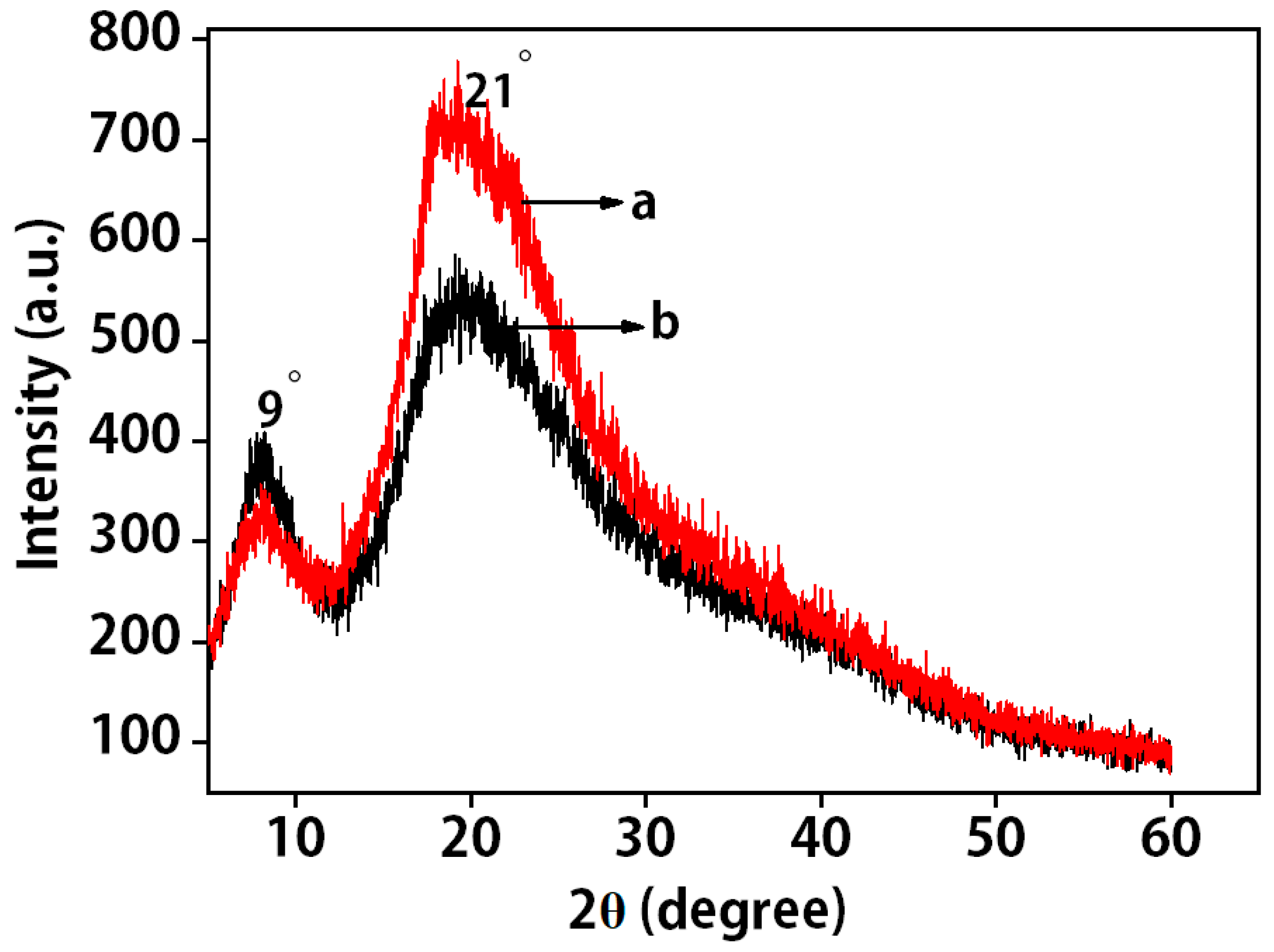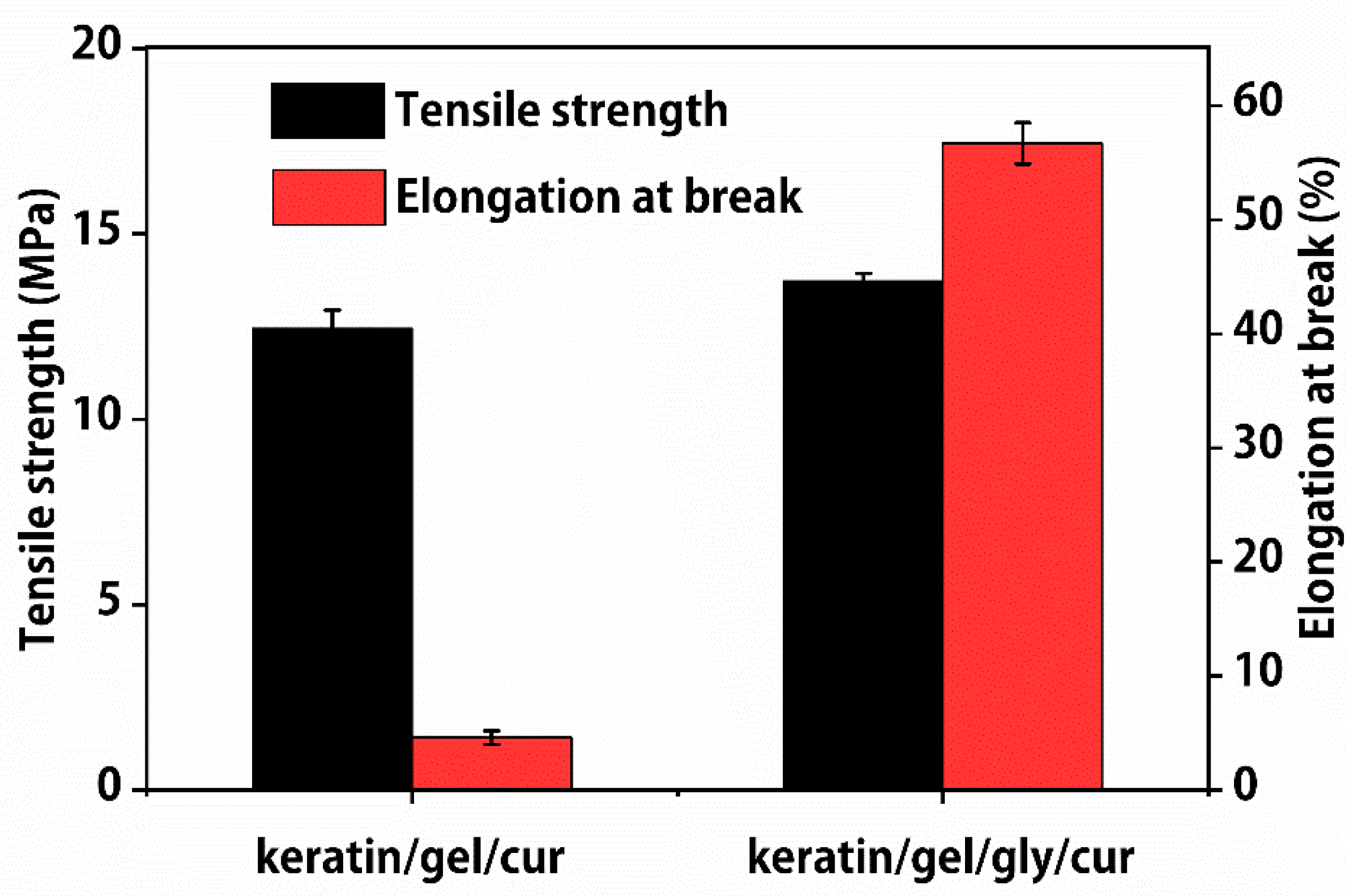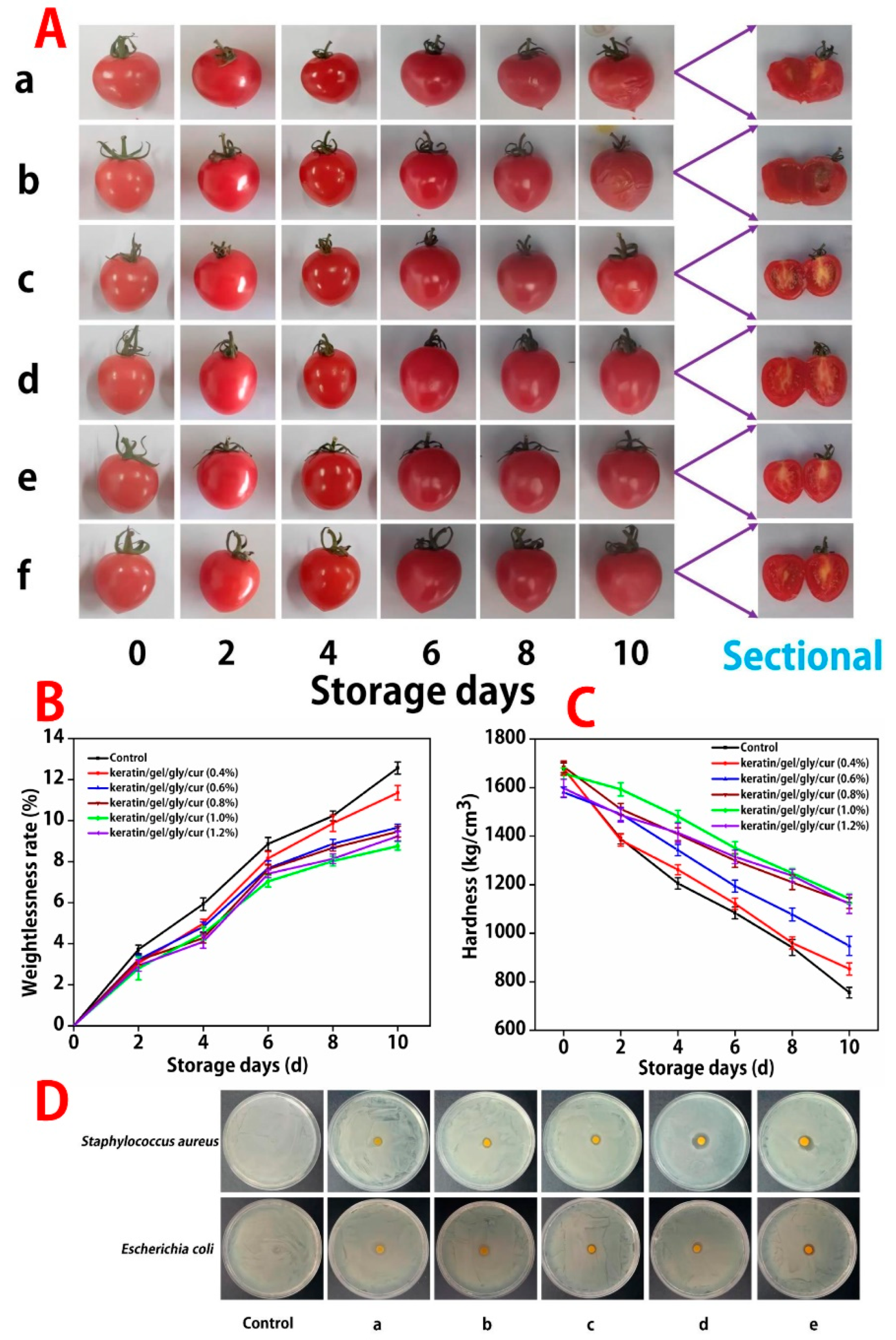Keratin-Based Composite Bioactive Films and Their Preservative Effects on Cherry Tomato
Abstract
:1. Introduction
2. Results and Discussion
2.1. SEM of Pig Nail Powders and Pig Nail Keratin
2.2. XRD Analysis of Pig Nail Powders and Pig Nail Keratin
2.3. SEM of the Composite Films
2.4. Mechanical Property of the Composite Films
2.5. Characterization of Different Kinds of Composite Films
2.6. The Application to Preserve Cherry Tomatoes
2.7. The Antibacterial Activity of Keratin/gel/gly/cur Composite Films
3. Materials and Methods
3.1. Materials and Reagents
3.2. Extraction of Keratin from Pig Nails
3.3. Preparation of Keratin/Gelatin/Glycerol/Curcumin Films
3.4. Characterization
3.5. Mechanical Properties
3.6. Application of Composite Films to Store Cherry Tomatoes
3.7. Antibacterial Property of Composite Films
3.8. The Ratio of Weight Loss
3.9. Hardness
3.10. Thickness
3.11. Surface Color
3.12. Statistical Analysis
4. Conclusions
Author Contributions
Funding
Institutional Review Board Statement
Informed Consent Statement
Data Availability Statement
Acknowledgments
Conflicts of Interest
Sample Availability
References
- Sarma, P.K. Postharvest losses of tomato: A value chain context of Bangladesh. Int. J. Agric. Educ. Extn. 2018, 4, 85–92. [Google Scholar]
- Kabir, S.N.; Rasool, K.; Lee, W.-H.; Cho, S.-I.; Chung, S.-O. Influence of delayed cooling on the quality of tomatoes (Solanum lycopersicum L.) stored in a controlled chamber. AIMS Agric. Food 2020, 5, 272. [Google Scholar] [CrossRef]
- Al-Dairi, M.; Pathare, P.B. Kinetic modeling of quality changes of tomato during storage. Agric. Eng. Int. CIGR J. 2021, 23, 183–193. [Google Scholar]
- Barrett, D.M.; Beaulieu, J.C.; Shewfelt, R. Color, Flavor, Texture, and Nutritional quality of fresh-cut fruits and vegetables: Desirable levels, instrumental and sensory measurement, and the effects of processing. Crit. Rev. Food Sci. 2010, 50, 369–389. [Google Scholar] [CrossRef]
- Priyadarshi, R.; Negi, Y.S. Effect of varying filler concentration on zinc oxide nanoparticle embedded chitosan films as potential food packaging material. J. Polym. Environ. 2017, 25, 1087–1098. [Google Scholar] [CrossRef]
- Heidbreder, L.M.; Bablok, I.; Drews, S.; Menzel, C. Tackling the plastic problem: A review on perceptions, behaviors, and interventions. Scie. Total Environ. 2019, 668, 1077–1093. [Google Scholar] [CrossRef]
- Priyadarshi, R.; Kim, H.J.; Rhim, J.W. Effect of sulfur nanoparticles on properties of alginate-based films for active food packaging applications. Food Hydrocolloid 2020, 110, 106155. [Google Scholar] [CrossRef]
- Cui, H.; Yang, M.; Shi, C.; Li, C.; Lin, L. Application of Xanthan-Gum-Based Edible Coating Incorporated with Litsea cubeba Essential Oil Nanoliposomes in Salmon Preservation. Foods 2022, 11, 1535. [Google Scholar] [CrossRef]
- Zhou, Y.F.; Zhen, G.C.; Li, X.P.; Qi, W. Mix ratio design of membrane bag concrete. J. Hebei Eng. Technol. Colle. 2007, 127, 2648–2653. [Google Scholar]
- Wu, Y.W.; Han, C.Y.; Yang, J.H.; Jia, S.X.; Wang, S.G. Polypropylene films modified by air plasma and feather keratin graft. Surf. Coat. Technol. 2011, 206, 506–510. [Google Scholar] [CrossRef]
- Reichl, S. Films based on human hair keratin as substrates for cell culture and tissue engineering. Biomaterials 2009, 30, 6854–6866. [Google Scholar] [CrossRef] [PubMed]
- Dou, Y.; Zhang, B.N.; He, M.; Yin, G.Q.; Cui, Y.D.; Savina, I.N. Keratin/Polyvinyl alcohol blend films Cross-Linked by dialdehyde starch and their potential application for drug release. Polymers 2015, 7, 580–591. [Google Scholar] [CrossRef]
- Ke, T.Y.; Li, D.X.; Yang, X.H. Preparation and properties of Keratin/CMC blend membranes. Adv. Mater. Res. 2013, 647, 190–194. [Google Scholar] [CrossRef]
- Bertini, F.; Canetti, M.; Patrucco, A.; Zoccola, M. Wool keratin-polypropylene composites: Properties and thermal degradation. Polym. Degrad. Stabil. 2013, 98, 980–987. [Google Scholar] [CrossRef]
- Feng, X.; Bansal, N.; Yang, H.S. Fish gelatin combined with chitosan coating inhibits myofibril degradation of golden pomfret (Trachinotus blochii) fillet during cold storage. Food Chem. 2016, 200, 283–292. [Google Scholar] [CrossRef]
- Clercq, K.D.; Schelfhout, C.; Bracke, M.; Wever, O.D.; Bockstal, M.V.; Ceelen, W.; Remon, J.P.; Vervaet, C. Genipin-crosslinked gelatin microspheres as a strategy to prevent postsurgical peritoneal adhesions: Invitro and invivo characterization. Biomaterials 2016, 96, 33–46. [Google Scholar] [CrossRef]
- Kose, H.; Aydin, A.O.; Akbulut, H. Sol-gel synthesis of nanostructured SnO2 thin film anodes for Li-Ion batteries. Acta Phys. Pol. A. 2012, 121, 227–229. [Google Scholar] [CrossRef]
- Gong, S.P.; Liu, J.Q.; Xia, J.; Quan, L.; Liu, H.; Zhou, D.X. Gas sensing characteristics of SnO2 thin films and analyses of sensor response by the gas diffusion theory. Mat. Sci. Eng. B-Adv. 2009, 164, 85–90. [Google Scholar] [CrossRef]
- Aggarwal, B.B.; Kumar, A.; Bharti, A.C. Anticancer potential of curcumin: Preclinical and clinical studies. Anticancer Res. 2003, 23, 363–398. [Google Scholar]
- Kant, V.; Gopal, A.; Pathak, N.N.; Kumar, P.; Tandan, S.K.; Kumar, D. Antioxidant and anti-inflammatory potential of curcumin accelerated the cutaneous wound healing in streptozotocin-induced diabetic rats. Int. Immunopharmacol. 2014, 20, 322–330. [Google Scholar] [CrossRef]
- Portes, E.; Gardrat, C.; Castellan, A.; Coma, V. Environmentally friendly films based on chitosan and tetrahydrocurcuminoid derivatives exhibiting antibacterial and antioxidative properties. Carbohyd. Polym. 2009, 76, 578–584. [Google Scholar] [CrossRef]
- Meral, R.; Alav, A.; Karakas, C.Y.; Dertli, E.; Ceylan, Z. Effect of electrospun nisin and curcumin loaded nanomats on the microbial quality, hardness and sensory characteristics of rainbow trout fillet. LWT-Food Sci. Technol. 2019, 113, 108292. [Google Scholar] [CrossRef]
- Li, S.; Yang, X.H. Fabrication and Characterization of Electrospun Wool Keratin/Poly(vinyl alcohol) Blend Nanofibers. Adv. Mater. Sci. Eng. 2014, 2014, 163678. [Google Scholar] [CrossRef]
- Sonkaew, P.; Sane, A.; Suppakul, P. Antioxidant Activities of Curcumin and Ascorbyl Dipalmitate Nanoparticles and their Activities after Incorporation into Cellulose-Based Packaging Films. J. Agr. Food Chem. 2012, 60, 5388–5399. [Google Scholar] [CrossRef] [PubMed]
- Ruan, C.Q.; Kang, X.O.; Zeng, K.F. Preparation of water-soluble dialdehyde cellulose enhanced chitosan coating and its application on the preservation of mandarin fruit. Int. J. Biol. Macromol. 2022, 203, 184–194. [Google Scholar] [CrossRef]
- Ji, M.C.; Li, J.Y.; Li, F.Y.; Wang, X.J.; Man, J.; Li, J.F.; Zhang, C.W.; Peng, S.X. A biodegradable chitosan-based composite film reinforced by ramie fibre and lignin for food packaging. Carbohyd. Polym. 2022, 281, 119078. [Google Scholar] [CrossRef]
- Aloui, H.; Ghazouani, Z.; Khwaldia, K. Bioactive Coatings Enriched with Cuticle Components from Tomato Wastes for Cherry Tomatoes Preservation. Waste Biomass Valori. 2021, 12, 6155–6163. [Google Scholar] [CrossRef]
- Lan, W.J.; Wang, S.Y.; Chen, M.R.; Sameen, D.E.; Lee, K.; Liu, Y.W. Developing poly(vinyl alcohol)/chitosan films incorporate with d-limonene: Study of structural, antibacterial, and fruit preservation properties. Int. J. Biol. Macromol. 2020, 145, 722–732. [Google Scholar] [CrossRef]
- Sun, X.Z.; Williams, G.R.; Hou, X.X.; Zhu, L.M. Electrospun curcumin-loaded fibers with potential biomedical applications. Carbohyd. Polym. 2013, 94, 147–153. [Google Scholar] [CrossRef]
- Sucheta; Chaturvedi, K.; Sharma, N.; Yadav, S.K. Composite edible coatings from commercial pectin, corn flour and beetroot powder minimize post-harvest decay, reduces ripening and improves sensory liking of tomatoes. Int. J. Biol. Macromol. 2019, 133, 284–293. [Google Scholar]
- He, M.; Zhang, B.N.; Dou, Y.; Yin, G.Q.; Cui, Y.D. Blend modification of feather keratin-based films using sodium alginate. J. Appl. Polym. Sci. 2016, 134, 44680. [Google Scholar] [CrossRef]







| Days | Control | 1 | 2 | 3 | 4 | 5 | |
|---|---|---|---|---|---|---|---|
| Luminosity (L*) | 0 | 30.25 (0.41) a,u | 30.07 (0.61) a,u | 30.27 (0.29) a,u | 30.92 (0.34) a,u | 30.03 (0.31) a,u | 30.62 (0.97) a,u |
| 2 | 28.93 (0.36) b,u | 29.27 (0.19) b,u | 29.28 (0.89) a,b,u | 29.81 (0.14) b,u | 29.54 (0.13) a,b,u | 30.16 (0.53) a,b,u | |
| 4 | 28.26 (0.18) b,w | 28.38 (0.20) b,c,v,w | 28.67 (0.16) b,c,u,v,w | 28.85 (0.15) c,u,v | 28.63 (0.31) b,c,v,w | 29.20 (0.29) b,c,u | |
| 6 | 27.53 (0.17) c,v | 27.62 (0.25) c,u,v | 28.03 (0.55) c,d,u,v | 28.26 (0.26) d,u,v | 28.02 (0.48) c,d,u,v | 28.61 (0.53) b,c,d,u | |
| 8 | 26.82 (0.46) d,v | 27.06 (0.13) d,u,v | 27.26 (0.13) d,e,u,v | 27.68 (0.13) d,e,u,v | 27.60 (0.85) c,d,u,v | 28.19 (0.33) c,d,u | |
| 10 | 26.03 (0.18) e,w | 26.36 (0.28) d,v | 26.80 (0.12) e,v | 27.15 (0.34) e,u,v | 27.24 (0.49) d,u,v | 27.62 (0.19) d,u | |
| Chroma (C*ab) | 0 | 28.94 (0.92) a,u,v,w | 28.98 (1.46) a,u,v,w | 26.92 (0.47) a,w | 27.20 (0.94) a,v,w | 29.71 (1.25) a,u,v | 31.05 (1.26) a,u |
| 2 | 27.19 (0.52) a,v,w | 28.58 (0.94) a,b,u,v | 25.97 (0.24) a,b,w | 26.07 (0.77) a,b,w | 28.77 (0.64) a,b,u,v | 30.11 (0.83) a,u | |
| 4 | 26.98 (1.47) a,u,v | 26.88 (0.96) a,b,c,u,v | 25.72 (0.30) a,b,v | 25.34 (0.71) b,c,v | 27.33 (0.32) b,c,u,v | 29.04 (1.35) a,u | |
| 6 | 26.40 (1.46) a,u,v,w | 26.53 (0.28) b,c,u,v,w | 25.68 (1.21) a,b,v,w | 24.43 (0.43) b,c,w | 27.44 (0.50) b,c,u,v | 28.61 (0.50) a,u | |
| 8 | 22.75 (1.20) b,x | 25.84 (0.41) c,u,v,w | 24.40 (1.45) b,c,v,w,x | 23.96 (0.60) c,w,x | 27.26 (0.28) b,c,u,v | 28.28 (2.39) a,u | |
| 10 | 22.39 (0.50) b,x | 25.13 (1.26) c,v,w | 23.35 (1.10) c,w,x | 23.82 (0.71) c,v,w,x | 26.50 (0.90) c,u,v | 28.16 (1.83) a,u | |
| Hue angle (H*ab) | 0 | 30.40 (1.66) a,u | 29.06 (1.36) a,u,v | 29.11 (0.81) a,u,v | 27.51 (0.72) a,v | 27.18 (0.26) a,v | 28.94 (0.27) a,u,v |
| 2 | 30.30 (1.06) a,u | 28.67 (1.04) a,u | 28.95 (0.68) a,u | 26.01 (0.72) a,w | 26.59 (0.49) a,v,w | 28.36 (0.75) a,b,u,v | |
| 4 | 27.06 (2.44) ab,u | 27.00 (1.02) a,u | 27.17 (0.38) a,b,u | 25.96 (2.30) a,u | 26.09 (0.38) a,u | 27.90 (0.30) a,b,u | |
| 6 | 25.84 (1.59) b,u | 25.4 (0.86) a,b,u | 26.23 (1.58) b,u | 25.58 (0.74) a,u | 25.34 (0.92) a,u | 27.73 (0.91) a,b,u | |
| 8 | 22.43 (1.04) c,w | 20.94 (2.36) b,c,v,w | 25.32 (0.65) b,u | 24.09 (0.26) a,b,u,v | 24.86 (0.89) a,b,u | 26.68 (1.36) a,b,u | |
| 10 | 19.43 (0.80) c,v | 18.57 (3.71) c,v | 21.83 (1.61) c,u,v | 20.89 (3.35) b,u,v | 22.29 (2.40) b,u,v | 26.08 (1.60) b,u | |
Publisher’s Note: MDPI stays neutral with regard to jurisdictional claims in published maps and institutional affiliations. |
© 2022 by the authors. Licensee MDPI, Basel, Switzerland. This article is an open access article distributed under the terms and conditions of the Creative Commons Attribution (CC BY) license (https://creativecommons.org/licenses/by/4.0/).
Share and Cite
Wei, L.; Zhu, S.; Yang, H.; Liao, Z.; Gong, Z.; Zhao, W.; Li, Y.; Gu, J.; Wei, Z.; Yang, J. Keratin-Based Composite Bioactive Films and Their Preservative Effects on Cherry Tomato. Molecules 2022, 27, 6331. https://doi.org/10.3390/molecules27196331
Wei L, Zhu S, Yang H, Liao Z, Gong Z, Zhao W, Li Y, Gu J, Wei Z, Yang J. Keratin-Based Composite Bioactive Films and Their Preservative Effects on Cherry Tomato. Molecules. 2022; 27(19):6331. https://doi.org/10.3390/molecules27196331
Chicago/Turabian StyleWei, Lanlan, Shuaijie Zhu, Huan Yang, Zhiheng Liao, Zexuan Gong, Wenwen Zhao, Yan Li, Jinyan Gu, Zhaohui Wei, and Jianting Yang. 2022. "Keratin-Based Composite Bioactive Films and Their Preservative Effects on Cherry Tomato" Molecules 27, no. 19: 6331. https://doi.org/10.3390/molecules27196331
APA StyleWei, L., Zhu, S., Yang, H., Liao, Z., Gong, Z., Zhao, W., Li, Y., Gu, J., Wei, Z., & Yang, J. (2022). Keratin-Based Composite Bioactive Films and Their Preservative Effects on Cherry Tomato. Molecules, 27(19), 6331. https://doi.org/10.3390/molecules27196331






